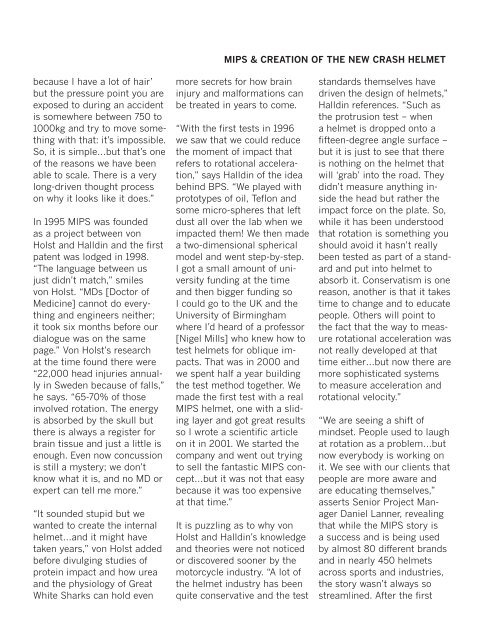You also want an ePaper? Increase the reach of your titles
YUMPU automatically turns print PDFs into web optimized ePapers that Google loves.
MIPS & CREATION OF THE NEW CRASH HELMET<br />
because I have a lot of hair’<br />
but the pressure point you are<br />
exposed to during an accident<br />
is somewhere between 750 to<br />
1000kg and try to move something<br />
with that: it’s impossible.<br />
So, it is simple…but that’s one<br />
of the reasons we have been<br />
able to scale. There is a very<br />
long-driven thought process<br />
on why it looks like it does.”<br />
In 1995 MIPS was founded<br />
as a project between von<br />
Holst and Halldin and the first<br />
patent was lodged in 1998.<br />
“The language between us<br />
just didn’t match,” smiles<br />
von Holst. “MDs [Doctor of<br />
Medicine] cannot do everything<br />
and engineers neither;<br />
it took six months before our<br />
dialogue was on the same<br />
page.” Von Holst’s research<br />
at the time found there were<br />
“22,000 head injuries annually<br />
in Sweden because of falls,”<br />
he says. “65-70% of those<br />
involved rotation. The energy<br />
is absorbed by the skull but<br />
there is always a register for<br />
brain tissue and just a little is<br />
enough. Even now concussion<br />
is still a mystery; we don’t<br />
know what it is, and no MD or<br />
expert can tell me more.”<br />
“It sounded stupid but we<br />
wanted to create the internal<br />
helmet…and it might have<br />
taken years,” von Holst added<br />
before divulging studies of<br />
protein impact and how urea<br />
and the physiology of Great<br />
White Sharks can hold even<br />
more secrets for how brain<br />
injury and malformations can<br />
be treated in years to come.<br />
“With the first tests in 1996<br />
we saw that we could reduce<br />
the moment of impact that<br />
refers to rotational acceleration,”<br />
says Halldin of the idea<br />
behind BPS. “We played with<br />
prototypes of oil, Teflon and<br />
some micro-spheres that left<br />
dust all over the lab when we<br />
impacted them! We then made<br />
a two-dimensional spherical<br />
model and went step-by-step.<br />
I got a small amount of university<br />
funding at the time<br />
and then bigger funding so<br />
I could go to the UK and the<br />
University of Birmingham<br />
where I’d heard of a professor<br />
[Nigel Mills] who knew how to<br />
test helmets for oblique impacts.<br />
That was in 2000 and<br />
we spent half a year building<br />
the test method together. We<br />
made the first test with a real<br />
MIPS helmet, one with a sliding<br />
layer and got great results<br />
so I wrote a scientific article<br />
on it in 2001. We started the<br />
company and went out trying<br />
to sell the fantastic MIPS concept…but<br />
it was not that easy<br />
because it was too expensive<br />
at that time.”<br />
It is puzzling as to why von<br />
Holst and Halldin’s knowledge<br />
and theories were not noticed<br />
or discovered sooner by the<br />
motorcycle industry. “A lot of<br />
the helmet industry has been<br />
quite conservative and the test<br />
standards themselves have<br />
driven the design of helmets,”<br />
Halldin references. “Such as<br />
the protrusion test – when<br />
a helmet is dropped onto a<br />
fifteen-degree angle surface –<br />
but it is just to see that there<br />
is nothing on the helmet that<br />
will ‘grab’ into the road. They<br />
didn’t measure anything inside<br />
the head but rather the<br />
impact force on the plate. So,<br />
while it has been understood<br />
that rotation is something you<br />
should avoid it hasn’t really<br />
been tested as part of a standard<br />
and put into helmet to<br />
absorb it. Conservatism is one<br />
reason, another is that it takes<br />
time to change and to educate<br />
people. Others will point to<br />
the fact that the way to measure<br />
rotational acceleration was<br />
not really developed at that<br />
time either…but now there are<br />
more sophisticated systems<br />
to measure acceleration and<br />
rotational velocity.”<br />
“We are seeing a shift of<br />
mindset. People used to laugh<br />
at rotation as a problem…but<br />
now everybody is working on<br />
it. We see with our clients that<br />
people are more aware and<br />
are educating themselves,”<br />
asserts Senior Project Manager<br />
Daniel Lanner, revealing<br />
that while the MIPS story is<br />
a success and is being used<br />
by almost 80 different brands<br />
and in nearly 450 helmets<br />
across sports and industries,<br />
the story wasn’t always so<br />
streamlined. After the first

















